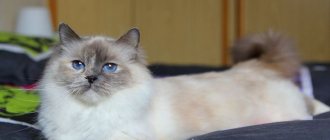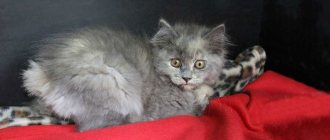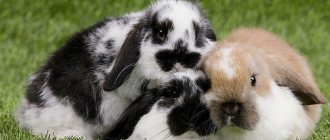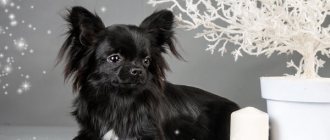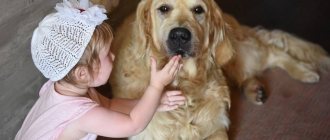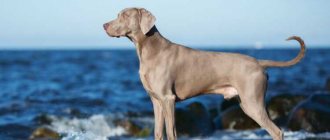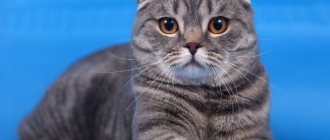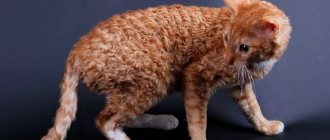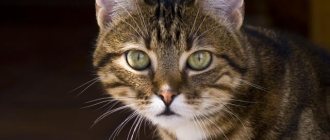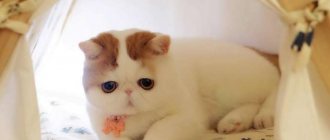Persian
Long silky hair (of any color), round green or yellow eyes, a flattened muzzle with an upturned nose - these are the characteristic features of a purebred Persian. His character can be either capricious or pliable, calm.
Thanks to the long, thick fur, the size of the Persian cat visually increases, but after a bath you can be very surprised by the size of the pet, because they will be much smaller than it seems.
Among the representatives of this cat breed there are also their own types:
- Classic (nose slightly below the eye line).
- European (the edge of the nose is at the same level as the lower eyelid).
- Extreme (nose in line with the inner corners of the eyes).
British breed
The British breed has become incredibly popular over the past 10 years, especially among urban families with children and busy work schedules. This large-eyed cat breed is now divided into two branches: longhair and shorthair. The differences are purely external; the length of the fur did not affect the character in any way.
The British are loved not only for their plushness, but also for their ease of care, intelligence, delicacy and affection for the family. Cats of this breed are unobtrusive, but they really love to be with their family, even if just lying on their bed. British cats also get along well with other pets, sometimes even with guinea pigs and ferrets, since the hunting instinct is very dull.
Exotic Shorthair
In shortened form, this breed of cat with a flattened muzzle and large eyes is called exotic. She owes her appearance to the crossing of Persians with an American shorthair cat. In appearance, exotics are very reminiscent of extreme Persians, but unlike the latter, they have short, soft hair, which saves owners from the need to spend a lot of time on regular grooming. Among the characteristic features: strong short legs, an expanded chest and large size (the weight of some animals exceeds 8 kg). The color of representatives can be very diverse, from white and black to noble blue.
The cute plush appearance of the exotic cat fully matches its character. These pets differ from their Persian ancestors in a more affectionate, playful disposition, without unnecessary aggression, and therefore are considered an ideal option for families with children. They rarely speak, love their owner very much and get along without problems in the same territory with other animals.
The history of flat-faced cats
It is generally accepted that people domesticated the first cats about 12 thousand years ago. Moreover, at that time these were wild animals living on their own in natural conditions. And various cat breeds began to actively appear in the last few centuries, as specialists bred various animals with a specific skeletal structure and coat color to suit different needs and requests.
The history of flat-faced cats begins around 500 BC. The Dutch traveler noted in his notes that he saw amazing cats with long and fluffy hair at the court of the first kings of Persia, Cambyses and Darius.
It was the Persian kings who were the first to glorify the new breed of cats; Cats got their name from the name of the state
Thanks to his beautiful appearance, the future progenitor of Persian cats (and this is how the story of the appearance of “Persians” in the world begins) was the favorite of many royal and noble persons. The preservation of the randomly obtained breed was ensured until the 16th century, when the Persian cat was brought to Europe.
Here, the “Persians” also became favorites at the courts, and therefore the development of the breed continued to the form that we can see today.
Felinological organizations are very sensitive to determining whether an individual belongs to a particular breed. Thus, according to various estimates, from 35 to 74 cat breeds are still recognized in the world. The Persian cat is one of those breeds that have been recognized by all felinologists in the world.
And, for example, British cats were originally called “shorthair” in England and were registered as a separate breed in the 1930s. However, the history of the breed goes back to the Middle Ages, when, due to a gene mutation, cats with flattened faces began to appear at the court of the English nobility.
Around the 1920s and 1930s, Sweden and the United States began crossing Siamese and Persian cats, eventually creating a new breed, the Himalayan cat. Only by 1980 was it possible to consolidate breed standards and distinguish the Himalayan as a separate species of cat.
In the 1960s, Persian and American Shorthair cats were crossed in the United States. As a result, a new breed appeared, called exotic. Exotics initially frightened breeders with their appearance, but the breed quickly gained popularity: first in the USA, and then in other countries of the world. In the early 1980s, exotics were legalized as a full-fledged cat breed.
The story of the Scottish cat begins very unexpectedly: the farm cat Susie was born with a strong mutation (brachycephalic skull shape and small ears bent forward). In the 1960s, there were no such pets in Scotland, so Susie's offspring were crossed with British cats. As a result, it was possible to create a new breed, which was named Scottish in honor of the place of residence of the ancestor cat.
Scientific point of view
A cat's unusual flattened face is the result of a serious genetic disorder. In scientific circles, this phenomenon is called “brachycephaly.” The term is literally translated from Latin as “short head” and indeed, in brachycephalics, the length of the head occupies up to 80% of the width of the skull and is strongly flattened in front.
The skeleton shows that the skull has a rounded surface and is flattened in the front.
There is a point of view that domestic cats inherited this skull shape from their common ancestor - the wild cat Pallas's cat. However, whether this is actually the case is not known for sure.
Geneticists and breeders have worked to ensure that, over the course of all generations, the brachycephalic features of the skull have been fixed in some cat breeds. The work was carried out in such a way that only those individuals whose flattened muzzle was the main feature were crossed.
Himalayan
Another breed of cat with a short nose is the Himalayan, obtained from crossing Persians with Siamese. It is recognized only by the TICA and CFF associations. Others consider it a subspecies of the Persian and register it that way.
In addition to the snub nose, the distinctive features of the Himalayan's appearance include bright blue eyes, a large body with short legs and increased fluffiness. The coat color is color point with transitions from beige on the body to dark brown on the nose, ears, tail and limbs.
Pets of the Himalayan breed are distinguished by a calm, even lazy character: they rarely play, and like to sleep more than others. Due to this lethargy, they can be called ideal pets for cuddling.
With some stretch, British Shorthair and Scottish Fold cats can also be considered breeds with a flat nose. The brachycephalic type of skull is not as pronounced in them as in the Persians, Exotics and Himalayans presented above.
How they appeared and what they are
Some scientists argue that Persian cats have existed since the founding of Persia. Although references to charming cats with luxurious fur date back to the 17th century.
The emergence of the Persian Longhair dates back to 1887. Then they were divided into several subspecies, which served as an incentive for the creation of clubs for cat lovers. And at the beginning of the 20th century they became the first breed officially recognized by the English Felinological Association.
In the 20s, a subtype of the Persian appeared - extreme, and in the 50s, by crossing it with a Siamese, the Himalayan cat was created. In the 60s, a Persian cat gave birth to kittens from an American Shorthair, which were later called Exotic Shorthairs. In the Soviet Union, they first learned about such pets in 1980, and their breeding began in 1991.
Among the distinctive features of snub-nosed cats are the following characteristics:
- brachycephalic muzzle with a depressed nose;
- cheeky head, the width of which is more than 80% of the height;
- stocky build with a small body and short powerful legs;
- small ears widely spaced on the head;
- thick plush fur of medium or long length.
Such pets are very affectionate and pliable, friendly with others, and especially with children. They become very attached to their owner, with whom they like to spend as much time as possible.
Manul
Despite the fact that breeds with a flattened face are bred artificially, there are also cats in nature with this feature. This is a Pallas's cat that lives in the countries of Central Asia. It is approximately the same size as its domestic relatives, but has a more “predatory” appearance: a squat, massive body with short legs, a flat skull with a powerful jaw, and very thick long hair. The image is complemented by a small head with small rounded ears and yellow eyes.
Thanks to its brachycephalic skull, the Pallas cat has two advantages. Firstly, a strong jaw, which allows you to firmly hold your prey. Secondly, the ability to breathe through your mouth, so as not to loosen your iron grip even for a minute. The color with a combination of light gray and yellow-brown shades provides reliable camouflage in the wild, which is especially important during hunting. Pallas's cat is a rare species of animal and is listed in the Red Book. Despite this, there are those who want to domesticate it, which is almost impossible to do in reality.
Top breeds
There are not many varieties of flat-nosed cats, of which only five have been finally bred and recognized by the world. First of all, it is worth mentioning the Persian beauties, from which the exotic and Himalayan originated. The Scottish Fold and the British Teddy are quite popular, and the Pallas's cat is the only representative of the wild among them.
Persian
Long thick hair that requires regular grooming, round eyes of green or yellow color and a sweet flattened muzzle with an upturned nose - this is a description of a purebred Persian. It can have any color, but this will not make it any less recognizable. The character is sometimes capricious and demanding, but more often soft and gentle, which is balanced by truly royal calm.
Based on the shape of their muzzle, they were divided into several subspecies:
- classic with a noticeable nose located just below the eyes;
- extreme sports are distinguished by a concave nose in line with the eyes;
- the modern nose is short, its tip is at or above the lower eyelid.
Persian cats are completely domestic, so you shouldn’t let them outside. Although they require constant attention, they will get along well with other inhabitants of the house. Good manners and complaisance are instilled in a pet from childhood.
Exotic Shorthair
Exotics do not have long hair like Persians, which many see as only a plus.
The concave nose, along with the convex forehead and rounded outlines, gives the muzzle a cute expression. His squat build and incredible friendliness make him look like a plush toy. The character of such a pet is peaceful, calm and without unnecessary aggression.
Scottish fold
The Scottish Fold, in addition to its slightly flattened face, has a special structure of ears, which are pressed to the head and hang slightly forward. The body is medium, and the coat is practically never long, but always full. This gives her the appearance of a kitten with an always curious look and a playful mood.
The Scottish's muzzle is not as flat as that of similar breeds, so it is unpretentious in food and care. This is a very sociable pet who loves to play with children and owners, but does not like loneliness.
British
In appearance they resemble the Scots, with the exception of the shape of the ears, which for the British is quite common and straight. The short pile resembles plush and is more often found in ash tones, and the eyes of a purebred representative are golden. The face with rounded cheeks is not too flattened, which softens the features and makes them more attractive.
The British have elegant manners, and their sedateness and calmness will please most owners. This cat is easy to train and has high intelligence. He tolerates loneliness calmly and rarely conflicts with anyone.
Himalayan
The Himalayan cat was created by crossing a Persian and a Siamese, which significantly affected its appearance. She has a characteristic color-point color with a transition from beige on the body to dark brown on the paws, tail, ears and nose.
His disposition is very calm and affectionate, even slightly lazy. They tolerate any manipulation from people and treat children well. They are not recognized in all countries, so they are often registered as Persian Longhairs.
Pallas' cat
Pallas's cat is a predatory member of the cat family that lives in the wild. It has a tabby striped color and a strong, large body on short thick legs, covered with thick, long hair. The head is relatively small, with rounded ears and yellow eyes. The brachycephalic shape of the muzzle provides the animal with strong jaws and an iron grip, which helps in hunting.
It is almost impossible to housetrain him, but there are still those who want to.
The aggressive nature and habits of the predator make it completely different from ordinary pets.
Features of care
Many people like flat-faced cats for their innocent expression and unusual appearance. But if you want to become the owner of such a pet, you should take into account the possible difficulties of keeping them:
- Breathing problems. Due to their narrow, shortened airways, flat-faced cats often wheeze and snore while sleeping and even while feeding. They have a particularly difficult time with nasal congestion due to colds, so when choosing a Persian or exotic as a pet, it is especially important to regularly monitor the air temperature in the house and prevent hypothermia.
- Increased tear production. Due to shortened tear ducts, the risk of developing infection and suppuration under the eyelids increases. To prevent complications and for preventive purposes, watery eyes should be wiped with a cloth or paper napkin moistened with a special solution.
- Features of feeding. First, the food bowl must be wide enough. Secondly, not all pets can eat carefully. Despite the natural cleanliness of cats and regular licking, periodically the hair in the neck and mouth area needs to be wiped with a damp sponge. Some animals cannot eat food on their own at all, so owners have to spoon feed them.
How to care?
Flat-faced cats need proper care. Let's look at how to take care of these cute pets.
- Take care of your cats eyes. There is no need to constantly wash your eyes with water, especially if you have a Persian cat. It is better not to use cotton wool for processing - its lint can get into your eyes. When carrying out the procedure, use a paper napkin or cloth. They are moistened with a weak solution of boric acid or special drops, and then the cat’s eyes are cleaned, you can use the “Optic-gel” product.
- Give cats dry food to prevent the accumulation of plaque and tartar on the teeth. You can buy a chew toy. Brush your pet's teeth with a special paste at least once a month. Use a special brush purchased at a pet store.
- Check the ears of flat-faced cats regularly. Clean your ears with cotton swabs at least once a month. As soon as your pet's ears become dirty, they should be cleaned immediately.
- Take care of the normal condition of the animal's claws. Buy or make a scratching post. Trim your nails once a month using a nail clipper. Cut off the excess part evenly and capture no more than 2 mm.
- Brush long-haired pets every day, bathe cats. If the coat is long, then this should be done once every 8-12 weeks.
- Feed your pet high-quality natural food or premium and super-premium food. You cannot feed salted, smoked, fried, fatty, sweet foods, as well as cheap economy-class food.
See below about the characteristics of exotics.
Are your cat's eyes healthy? Test at home
Problems with a cat's vision are something that owners often pay attention to last, because the cat does not refuse food, does not stop playing and purring, and in most cases behaves as usual. One of the peculiarities of cats is that with partial or even complete loss of vision, they adapt very quickly
The cat will be perfectly oriented in familiar conditions as long as all things remain in their places, and the owner will not even suspect that his pet needs help.
Here is a list of simple questions, by answering which you can understand whether everything is okay with your cat’s eyes.
Looking at the cat from the front, evaluate the condition of its eyes.
The answer to the questions below should be “yes”.
– Are the eyes the same size? – are they the same shape? – are the pupils the same size? – is the cornea transparent? – if you shine a light into your eyes (or just turn on a bright light), will your pupils narrow? Are they the same size now? – if you move your finger in front of a cat’s eyes from left to right, will she follow it with both eyes? – what if up and down? – if you throw a small ball, will the cat see it?
And the answer to these questions should be “no”:
– Are the pupils cloudy? – are there “foggy” areas on the cornea? – are the outlines of blood vessels visible? – is there any discharge from the eyes? – Does the cat have strabismus? – is there any swelling on the eyelids? – is the third eyelid visible?
If the answers to any of these questions do not coincide with the norm, this is a reason to contact a veterinarian.
Let's look at an example
The picture shows the eyes of a healthy animal. What do we see?
1 Wide, fully open eyes of equal size. 2 No signs of redness 3 The iris (the colored part of the eye) is pure green, in this case, the color does not contain any spots or inclusions, is clean and clearly visible over the entire surface. 4 The pupils are the same size, but do not fill the entire iris (a healthy animal can have very dilated pupils only in the case of too little lighting, the effect of certain medications, or in case of severe fear). 5 The cornea is clean, transparent, allowing you to clearly see all the details of the eye. There are no opacities or visible vessels. 6 The third eyelid does not protrude from the corners of the eyes. 7 There is no discharge or swelling.
Here are some examples of what eyes can look like if you have diseases:
Corneal opacity
Discharge from the eyes
Third eyelid Redness and swelling of the eyelid
If you have reason to believe that the cat has become poorly sighted or has lost its vision altogether, you can do the following test: place a chair or some object in the center of the room that is not usually there, go behind it and call the cat. Even a blind cat will be able to follow its usual route without bumping into a wall or closet, since it remembers exactly what and where it was before, but a new obstacle on the way will become a problem if it loses its vision.
And remember that the condition of the eyes often reflects the health of the internal organs, so at the slightest sign of abnormalities, you need to show your pet to a veterinarian as soon as possible. Using any drops or ointments without a doctor's prescription (especially human ones) can cause irreparable harm to your cat's health.
Minuses
- Since the flattened shape of the face is not natural for cats, some problems arise from this. And sometimes in the literal sense of the word. These cats often have problems with nasopharyngeal congestion. A cat may snore and snort in its sleep. It's noisy.
- The brachycephalic type of muzzle in some people causes associations with an angry facial expression. This cat seems to be constantly dissatisfied with something. Or, on the contrary, it looks very naive. This form is also called a “doll” because it can resemble a child’s face. The associations are completely contradictory to each other, but they do exist.
Choosing a puppy
The price range of the breed has a lower limit of 2,500 rubles. This will be a puppy without documents, it is possible that pure blood can be forgotten, and there will be no question of patronage from the breeder. Puppies from breeders with documents cost from 23,000 to 35,000 rubles. Here you can already be sure of the quality of the litter and that the documents will not be fake.
Puppies from nurseries, with the appropriate pedigree and prospects for exhibitions and matings, will cost from 40,000 rubles. The price of the breed is due to its popularity; it can also explain the huge number of advertisements from private individuals who in no way guarantee the purity of the bulldog’s blood. In any case, remember that a purebred English bulldog is a “gentleman,” but a puppy from a private dog breeder may not become one.
Big-eyed Internet celebrities
Hermann
His popularity is just beginning to gain momentum, because Herman is still very young. This unusual kitten lives in Copenhagen. He appeared in Shirley's family quite recently - the girl adopted the animal from a shelter and at the same time his appearance did not bother her at all.
When Herman was very young, he had certain health problems: he gained weight poorly and grew slowly. But now this is in the past - the pet is happy in his new home, he is full of energy and surrounded by care, and has become popular on Instagram, more details on this page: https://ololo.tv/bug-eyed-cat-German-conquers-insta/.
Snoopy
This is the cutest cat in the world. His face is captivating and makes you smile sincerely. Snoopy was born in May 2011. And he appeared on the Internet thanks to his owner Nin. One day she posted a photo of her pet on Weibo and within two months this cute kitten had tens of thousands of fans.
After some time, Snoopy's popularity became incredibly huge, which forced his owner to create a blog, and then his personal page on Instagram and Facebook. Today this cat has several million fans around the world and their army continues to grow inexorably.
What are the main components of his success? Everything is very simple - in addition to natural charm, this cat has rather large brown eyes with which he looks at everyone with an innocent look.
Kobe
Kobe is a white cat with large blue eyes, which has become a rare, but at the same time very successful exception of its breed. British shorthaired chinchillas, which include Kobe, have a bluish-gray coat color and brown eye color. But this cat is a bright blue-eyed blonde.
Cobia has about 350 thousand followers on Instagram and approximately 6.5 thousand fans on Facebook. The owner of the beautiful Cobby Rebecca describes her as an extremely loyal pet who constantly follows her wet nurse, sleeps exclusively on her pillow and loves to play with water. Plus, as we all have seen, the fluffy blue-eyed blonde is incredibly photogenic and all her pictures turn out well.
Matilda
This cat with big eyes is called an alien. And her eyes really are like an alien's. Today, Matilda has about 35 thousand followers on Instagram, which is slightly less than Gimo, but much more than most of us.
At birth, Matilda had normal eyes and was no different from other cats. Upon reaching the 12th week of her life, she found a new family, in which she lives to this day. Matilda grew up and after a while the owners noticed that her eyes began to change: the pupil stopped narrowing and a squint appeared. Upon examination by a specialist, it turned out that the cat had a congenital pathology called spontaneous lens luxation. Moreover, this disease affected both eyes.
This disease has practically deprived Matilda of her sight: the cat sees very poorly, distinguishing only movements and light. Matilda is constantly monitored by a veterinarian and receives proper treatment. However, despite long-term therapy, experts believe that the animal still needs surgery.
Gimo
This cat has huge round eyes and a constantly dumbfounded look - no matter where he is and no matter what he does at the moment, this individual feature is always with him. Just one look at Gimo's photo is enough to remember him forever.
Don't miss: Muz-TV Award: date
Gimo's hypnotic eyes have conquered Instagram. This black cat with big eyes is one of the most famous and recognizable representatives of the feline world.
Devon rex
Hairless breeds took all the top positions in this ranking. Devon Rex is an exception! He has fur! A cat with a unique exterior resembles an alien. So he doesn’t look like the usual cute earthly cats. The thin body is covered with a suede curly fur coat. The awkward neck is completed by a tiny head with huge ears. And the expression of his elven face cannot be confused with anyone else.
In life, these pets are incredibly playful; cats occupy all the owner’s free time. As befits real space aliens, Devon Rexes are attracted by heights. Animals seek out and occupy the highest point in the room. It could also be the owner’s shoulders, if one is not found. Cats of this breed are extremely smart, easily learn commands, and perform tricks like a dog. The only command that Devons do not accept is “No!” when it comes to food.
What is the price
Kittens in Russia are offered for 25,000 – 75,000 rubles; in Ukraine – for 5,000 – 17,000 UAH.
Author's comment
These alien cats do not know moderation when it comes to food, often behave as if they have not eaten for a week, and do not disdain food from the human table.
Abyssinian
The direct ancestor of the Abyssinian is considered to be the African wild cat, which previously lived in Ethiopia. This area was in the past called Abyssinia, hence the name of the breed. In 1868, the first such cat was brought to England by the captain of a warship. He became the founder of the breed. The body shape of the Abyssinians of that time was completely different, and any colors were allowed. But over time, Abyssinian cats became what we are used to seeing them. The breed was officially registered in 1904, at which time its modern standard was established. During the First World War, the Abyssinians almost disappeared, but they were preserved in the United States. And these cats returned to Europe only after the end of the next war.
| Sign | Description |
| Body type | The sizes are average. The body is very flexible, slender |
| Head | Triangular shape. Round muzzle |
| Eyes | Almond-shaped. Color - amber, hazel or green |
| Ears | Wide at the base, rounded at the ends. Tassels are allowed |
| Tail | Long, thin |
| Limbs | Muscular, medium size. Paws are large and round |
| Wool | Short and soft. Its peculiarity is that each hair is colored in several shades at once. This is called ticking |
| Color | Four types of color are allowed: sorrel (base color is bright red, ticking is light brown); faun (main color - cream, ticking - beige); blue (main color - red, ticking - gray-blue); wild (ground color: reddish-brown; ticking: black) |
Abyssinian cats are very active, active and energetic. They do not require the owner’s attention all the time, but they do need time. This is especially true in cases where a person has been away from home for a long time (for example, at work).
Maine Coon
This breed is a semi-long-haired cat. The breed was bred in the USA, and is one of the largest purebred representatives in the world, created to live next to humans. This is a large breed of cat, with an extraordinary appearance, a variety of colors and an affectionate character.
The Maine Coon first appeared in Northeast America, in the state of Maine, about a hundred years ago. Part of the animal's name is associated with this area. The second component of the name in translation means raccoon or lynx, which is explained by the similarity of the fur coat with the coat of a raccoon. And with the presence of tassels, cats resemble a lynx.
The breed developed in northern climates, which explains the appearance of wide bones and long hair between the pads on the paws. Size does not match weight. Males weigh more than 10 kg. This breed of tasseled cats entered the Guinness Book of Records thanks to an amazing specimen weighing 16 kg.
Character
The Maine Coon is distinguished by its character and interesting features:
This ear-tufted cat adores her family and doesn't require much attention herself. They do not like loneliness; if you have to leave her alone for a while, you need to purchase various toys for the cat so that she does not get bored before the owners arrive. They love water and water procedures very much. There should always be a bowl of water next to the food for your pet to splash into. Maine Coon is able to communicate using different sounds. In addition to meowing, they make sounds similar to squeaks and trills. They have developed body language. If a cat wants to express a special reverent attitude, it hits its head. The breed is adapted to living in any climatic conditions. They can withstand winter cold and snowy weather without problems. Very friendly. The color of cats of this breed with tufted ears varies in 75 different color combinations. The breed includes both ginger cats and individuals with a chocolate color; lilac-colored specimens are possible, although these variations are recognized as a deviation from the standard and are not the norm for this species.
Maine is a coon with a half-meter tail, long hair, wide strong paws, powerful muscles and a large head. The cat's head is elongated, high cheekbones, triangular ears with tufts. The eyes of Maine Coon cats are oval-shaped, the color should be in harmony with the coat.
Care
Caring for this breed is easy:
- The coat needs to be brushed daily; Provide her with a scratching post;
- For food and water you need to place separate bowls, preferably made of glass or stainless steel;
- It has a tendency to develop periodontal disease; to prevent the disease, you need to regularly brush your pet’s teeth.
- The animal should be provided with its own corner, as it needs privacy from time to time. When the cat is in its corner, you should not touch it, so it will feel safe.
- It is recommended to feed the Maine Coon dry food, which will keep the teeth in good condition.
You can add to your diet:
- Raw beef;
- Cottage cheese;
- Quail eggs;
- Boiled chicken.
The Maine Coon is a breed of cat with tassels, included in the list of the most expensive species in the world ($4,000 to $80,000).
Siberian cat
Classics of the genre. Warm fur coat and bushy tail, massive build. It is worth noting the teeth: they are incredibly strong. If a cat wants to bite, he will really bite and it will hurt a lot.
There are tufts between the toes, indicating a wild forest origin. Development is slow, the cat develops only by 5 years. The front legs are shorter than the hind legs, which gives them agility and grace.
The special charm of the muzzle is given by slanted eyes, long eyebrows and mustaches, often curled like a spring.
An excellent option for people prone to allergies. The fact is that the saliva of a Siberian contains a minimum of allergen.
You especially need to take care of your eyes, they often fester. The coat is brushed 3 times a week.
A little selfish. They play when they want, they will not tolerate violence against the cat’s personality. Avid lovers of heights: every shelf will be examined, even the closet will not remain untouched. And they step softly, without dropping anything.
They hunt well, catching both mice and rats. They treat strangers poorly and defend their territory. According to a typical Siberian, the best place to rest is near the battery, with the paws spread and the tail extended.
Price: from 5000 rubles.
Do you want to know about other cats, such as caracals with tufted ears?
Watch the video:
https://youtube.com/watch?v=_VBgdHblChA%3F
